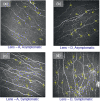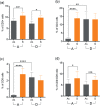Ocular Surface Immune Cell Profiles in Contact Lens-Induced Discomfort
- PMID: 35857328
- PMCID: PMC9315072
- DOI: 10.1167/tvst.11.7.16
Ocular Surface Immune Cell Profiles in Contact Lens-Induced Discomfort
Abstract
Purpose: Contact lens-induced discomfort (CLD) remains a primary factor in discontinuation or prevention of contact lens wear. Thus, we investigated the role of ocular surface immune cells in subjects with CLD.
Methods: Habitual contact lens (CL) wearers with CLD (n = 19; 38 eyes) and without CLD (n = 21; 42 eyes) as determined by the Contact Lens Dry Eye Questionnaire-8 was included in a trial. Enrolled subjects used either of the two types of CL (designated as CL-A or CL-D). Ocular surface cells from the bulbar conjunctiva were obtained by impression cytology. The collected cells were phenotyped using fluorochrome-conjugated antibodies specific for leukocytes (CD45+), neutrophils (CD66b+,High,Low), macrophages (CD163+), T cells (CD3+CD4+, CD3+CD8+), natural killer (NK) cells (CD56+, High, Low), natural killer T (NKT) cells (CD3+CD56+), and gamma delta T (γδT) cells (CD3+γδTCR+) by flow cytometry. Further, corneal dendritic cell density (cDCD) was also determined using in vivo confocal microscopy.
Results: Significantly higher proportions of CD45+ cells were observed in subjects with CLD compared to those without CLD. The percentages of CD66bTotal,Low, CD163+, pan T cells, CD4+T cells, CD8+T cells, CD56Total,High,Low (NK) cells, and NKT cells, as well as the CD4/CD8 ratio, were significantly higher in CLD subjects. The proportion of T cells (CD4, CD8, CD4/CD8 ratio, NKT cells) and macrophages exhibited a direct association with discomfort score. The percentages of CD45+, CD66bTotal,Low, CD163+, CD3+, CD56Total,High,Low, and NKT cells and cDCD were significantly higher in CLD subjects wearing CL-D. The percentages of CD66bHigh, CD4+T cells, CD8+T cells, NKT cells, and CD4/CD8 ratio were significantly higher in CLD subjects wearing CL-A.
Conclusions: Increased proportions of ocular surface immune cells are observed in CLD, and the lens type could impact the immune cells associated with CLD.
Translational relevance: The association between the proportion of altered ocular surface immune cell subsets and contact lens-induced discomfort underpins the importance of considering immune-related aspects during contact lens development and in the clinical management of ocular surface pain.
Conflict of interest statement
Disclosure:
Figures








References
-
- Dumbleton K, Caffery B, Dogru M, et al. .. The TFOS International Workshop on Contact Lens Discomfort: report of the subcommittee on epidemiology. Invest Ophthalmol Vis Sci. 2013; 54: TFOS20–TFOS36. - PubMed
-
- Dumbleton K, Woods CA, Jones LW, Fonn D.. The impact of contemporary contact lenses on contact lens discontinuation. Eye Contact Lens. 2013; 39: 93–99. - PubMed
-
- Pritchard N, Fonn D, Brazeau D.. Discontinuation of contact lens wear: a survey. Int Contact Lens Clin. 1999; 26: 157–162. - PubMed
-
- Young G, Veys J, Pritchard N, Coleman S.. A multi-centre study of lapsed contact lens wearers. Ophthalmic Physiol Opt. 2002; 22: 516–527. - PubMed
-
- Richdale K, Sinnott LT, Skadahl E, Nichols JJ.. Frequency of and factors associated with contact lens dissatisfaction and discontinuation. Cornea. 2007; 26: 168–174. - PubMed
Publication types
MeSH terms
LinkOut - more resources
Full Text Sources
Medical
Research Materials
Miscellaneous

